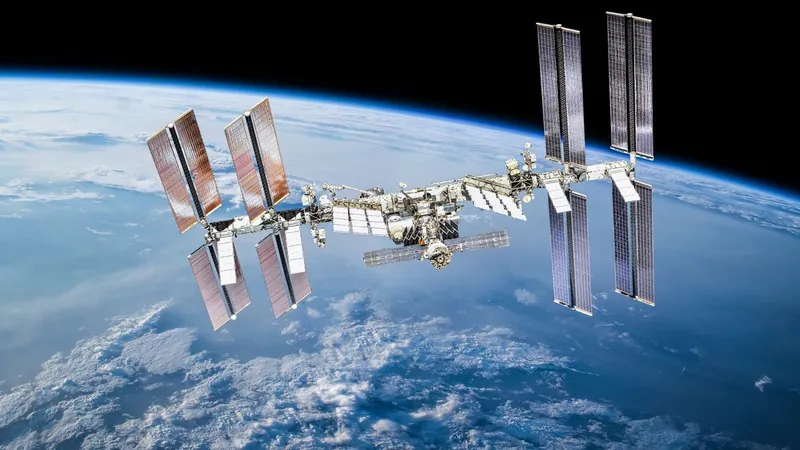
ISS Avoids 39th Close Call with Space Junk: How Long Can This Continue?
2024-11-26
Author: Daniel
Overview of the ISS's Evasive Maneuver
On November 19, 2024, the International Space Station (ISS) successfully navigated around a potentially hazardous piece of space debris from a satellite breakup in 2015, marking its 39th evasive maneuver since its launch in 1998. The ISS altitude was raised above its typical orbit of approximately 250 miles (440 kilometers) to avoid a fragment that could have come alarmingly close—about 2.5 miles (4 kilometers) away—had the maneuver not been executed.
Evasive Actions: Current Trends and Expert Insights
Despite only one such maneuver this year, down from five in 2023 and fewer compared to prior years (between 2020 and 2022), experts warn this is an anomaly rather than a trend. Hugh Lewis, a professor of astronautics at the University of Southampton, expressed concerns that future weeks may see an uptick in evasive actions as space debris continues to proliferate. “For all we know, next week there will be three maneuvers,” he cautioned.
The Bigger Picture: Space Junk is on the Rise
Space debris is any fragment of human-made machinery that remains in orbit after its intended use. Currently, there are approximately 29,000 objects over 4 inches (10 centimeters), but estimates suggest there are over 170 million pieces—totaling around 9,900 tons—ranging from screws to entire defunct satellites. These fragments pose a substantial threat as they travel at speeds of 18,000 mph (29,000 km/h), making even tiny pieces capable of causing catastrophic damage.
Collision Course: The Impact of Solar Activity
Interestingly, how often space debris approaches the ISS is influenced by solar activity, which follows an 11-year cycle with a current peak during the solar maximum. During these periods, the sun's activity expands Earth's atmosphere, increasing drag on debris in low orbits—likely raising the risk of collisions for the ISS. Lewis pointed out that we might see an increase in evasive actions during solar maximum.
A Near Miss: Taking Shelter From Space Junk
In June 2024, astronauts aboard the ISS faced a dramatic situation when fragments from a defunct Russian satellite forced them to seek refuge in a docked spacecraft. This scenario underlines the unpredictable nature of space debris threats. Fortunately, the ISS remained unharmed, but experts warn the ramifications could be severe. A strike from a sizeable fragment can breach the station’s shielding and jeopardize the lives of astronauts onboard.
What Lies Ahead: Cleaning Up Our Orbit
As NASA plans to retire the ISS in 2031, the calls for responsible behavior in space have intensified. The multiplying threat of debris means that actions must be taken to remove defunct satellites to reduce collision risks. Proponents argue that enforcing regulations regarding decommissioned satellites can massively impact the future of space travel, bringing stability to increasingly congested orbits.
Moreover, the problem calls for innovative solutions, such as debris removal technologies, to tackle this growing crisis. Companies like SpaceX, with its extensive Starlink satellite network, have already executed numerous maneuvers to evade debris, illustrating the urgent need for cooperation and regulation in low Earth orbit.
Conclusion: Urgency and Future Prospects
In summary, while the ISS has avoided significant collision threats for now, the booming space junk problem demands immediate attention and action. The future of not only the ISS but all space missions hinges on our ability to clean up Earth's orbit and prevent catastrophic incidents due to space pollution. Will we find a solution before it's too late? Only time will tell!


 Brasil (PT)
Brasil (PT)
 Canada (EN)
Canada (EN)
 Chile (ES)
Chile (ES)
 España (ES)
España (ES)
 France (FR)
France (FR)
 Hong Kong (EN)
Hong Kong (EN)
 Italia (IT)
Italia (IT)
 日本 (JA)
日本 (JA)
 Magyarország (HU)
Magyarország (HU)
 Norge (NO)
Norge (NO)
 Polska (PL)
Polska (PL)
 Schweiz (DE)
Schweiz (DE)
 Singapore (EN)
Singapore (EN)
 Sverige (SV)
Sverige (SV)
 Suomi (FI)
Suomi (FI)
 Türkiye (TR)
Türkiye (TR)